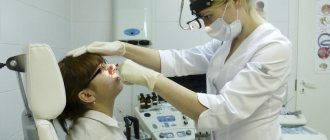Adenoids are glands consisting of lymphoid tissue, similar to tonsils. Unlike the tonsils, they cannot be seen when you open your mouth because they are located above the roof of your mouth. Adenoids grow during childhood and begin to shrink around age 8. In adults they are very small or absent. When the adenoids become too large (adenoid hypertrophy), they can cause an obstruction in the passage of air through the nose.
Adenoids, like tonsils, perform the function of producing lymphocytes and antibodies, helping the body protect itself from microorganisms that penetrate the nasal and oral cavity. Along with the palatine tonsils, they provide immune protection, which is especially important in childhood.
In some cases, the functions of the adenoids are disrupted: after repeated bacterial or viral attacks, this tissue increases excessively in volume (hypertrophy occurs), which is the cause of the appearance of characteristic symptoms. In children, inflammation of the adenoids is a common pathology leading to breathing problems and other complications that should not be overlooked.
Types of disease
Adenoid hypertrophy is classified depending on the degree of nasopharyngeal obstruction:
- I degree (obstruction less than 25%). Adenoid vegetation has spread to 1/3 of the nasopharynx and vomer. Difficulty breathing and discomfort are possible only at night when the child is sleeping.
- II degree (damage from 25% to 50% of lymphoid tissue). Accompanied by severe difficulty in nasal breathing during the daytime. The child does not sleep well at night due to snoring.
- III degree (between 50% and 75%). Adenoid vegetations are observed in most of the nasopharynx, completely covering the vomer. In rare cases, adenoids protrude into the lumen of the pharynx. The child breathes exclusively through the mouth, as nasal breathing becomes impossible.
Children with adenoid hypertrophy or recurrent adenoiditis usually have, in addition to symptoms of respiratory distress, signs of recurrent otitis media, chronic sinusitis, and persistent rhinitis.
Symptoms of enlarged adenoids
Because the adenoids trap germs that enter the body, sometimes the tissue becomes temporarily inflamed (as if it were swelling) in an attempt to fight off the infection. Often inflammation of the adenoids, called adenoiditis, is accompanied by tonsillitis and pharyngitis.
Clinical signs of adenoiditis in children are associated with three factors: a mechanical obstruction that occurs when the nasopharyngeal tonsils are enlarged, the development of an infectious process and a violation of reflex connections.
Inflamed or infected adenoids make breathing difficult and lead to the following problems:
- stuffy nose, which causes breathing through the mouth;
- snoring and problems with night sleep, which leads to daytime lethargy, weakened memory, fatigue and decreased performance at school;
- inflammation of the lymph nodes in the neck;
- hearing problems;
- quiet, monotonous and nasal voice (“nasal”).
The pressure of lymphoid tissue on the vascular structures of the mucous membrane leads to the appearance of edema and the development of a persistent runny nose. This makes nasal breathing even more difficult.
In infancy, hypertrophy of the adenoids is fraught with difficulty sucking, which is accompanied by systematic underfeeding and malnutrition. In this case, there is a decrease in blood oxygenation, which leads to the development of hypoxia.
If these signs appear, it is recommended to show the child to a specialist in the field of otolaryngology. The sooner measures are taken, the greater the chances of a complete recovery and the absence of complications.
Adenoids in adults
There is an opinion that adenoids (or pathological growth of the pharyngeal tonsil) is a disease exclusively of childhood. It would seem that this is so, because normally by the age of 12–16 years the pharyngeal tonsil degrades and often completely atrophies as unnecessary. However, in recent years, adenoid vegetations have increasingly begun to be detected in adults. Why is this happening?
Why is the pharyngeal tonsil needed?
The pharyngeal tonsil is an organ of the immune system located in the area of the nasopharynx. It is part of the so-called Pirogov’s lymphoid ring along with the paired palatine and tubal tonsils and the unpaired lingual tonsil. The main function of the pharyngeal tonsil is to create immunity and protect the body from a huge number of foreign agents with which the mucous membrane of our respiratory tract comes into contact.
The tonsils consist of lymphoid tissue, in which, in response to contact with an infectious agent or allergen, special cells of the immune system, lymphocytes, are “trained.” They remember information about each new alien so that the next time it enters the body, they immediately destroy it.
Normally, such “training” of the system continues on average until puberty, and then the tonsils, having fulfilled their purpose, decrease in size and almost completely disappear. It is quite logical that for the time being, adenoids were considered a childhood disease, because, in theory, adults simply do not have a pharyngeal tonsil.
Why do adenoids persist in adults?
As practice shows, this is not always the case, and there are factors that can prevent its reverse development, which leads to the preservation of adenoids in adulthood. These include:
- frequent and prolonged infections, allergies, exposure to polluted air - a compensatory enlargement of the amygdala occurs, so it tries to cope with the high level of stress on the immune system and protect the body from foreign substances;
- hormonal disorders in the body - diseases such as diabetes, obesity, can sometimes cause disturbances in the functioning of the pharyngeal tonsil;
- The genetic characteristics of the body are something that, unfortunately, cannot be controlled, while the tonsils enlarge in childhood and often remain in adults.
There is also an opinion that the more frequent detection of adenoids in adults is now associated not with the deterioration of people’s health, but with improved methods for diagnosing the disease. It is much more difficult to detect an enlarged pharyngeal tonsil in an adult than in a child, due to the peculiarities of the anatomical structure of the nasopharynx.
Symptoms of adenoids in an adult
Manifestations of adenoids are primarily due to the fact that an enlarged pharyngeal tonsil creates an obstacle to normal air movement. In adults, the symptoms are generally the same as in children. It is worth paying attention to:
- constantly stuffy nose and difficulty breathing;
- voice changes, nasality;
- snoring in sleep, cough;
- frequent diseases of the upper respiratory tract (pathological pharyngeal tonsil itself becomes a source of infection);
- frequent headaches;
- stuffy ears, frequent otitis media.
Combinations of symptoms can be very different. In some cases, a person will have all of the above symptoms at once, and in others - just one; sometimes the symptoms will appear at approximately the same time, and sometimes alternately. The reason to consult a doctor is any of the listed symptoms that do not go away for a long time and worsen the quality of life.
Diagnosis and treatment
The symptoms of adenoids are not very specific, so clarifying the diagnosis requires a detailed examination, which includes rhinoscopy (examination of the nasal cavity using special mirrors), as well as endoscopic and x-ray methods. In some controversial cases, a biopsy is performed to confirm the diagnosis.
If the pathology is confirmed, surgical treatment is most often prescribed. Now such an operation is considered to be low-traumatic; it is performed under endoscopic control under local or general anesthesia. The main methods at present are removal using a laser, cryodestructor, radio wave scalpel, shaver, etc. In some cases, when surgery is impossible (diseases of the blood coagulation system, acute infectious diseases, malignant formations), intranasal hormones, vasoconstrictors are used, to physiotherapy.
There is no need to be afraid of treatment, but if possible, it is still better to prevent the development of adenoids, and for this it is necessary to cure inflammatory diseases of the upper respiratory tract in a timely manner, strengthen the immune system and adhere to a healthy lifestyle. Take care of yourself!
Olga Starodubtseva
Photo istockphoto.com
Possible complications of the disease
If treatment of the inflammatory process in the adenoid area is not started in time, there is a risk of developing serious health consequences.
The most common complications of inflammation of the adenoids in children:
- weight loss/stunted growth;
- sleep apnea (the child stops breathing for a while);
- sinusitis (inflammation of the maxillary sinus);
- headaches, neuroses;
- partial and temporary deafness due to obstruction of the eustachian tube;
- otitis media and a feeling of stuffiness in the ears;
- impaired swallowing and sense of smell.
In children, adenoid hypertrophy can cause the tongue to move forward, the upper teeth to protrude, and the face to elongate. The adenoid type of face is characterized by a poorly developed jaw, short upper lip, raised nostrils and a curved palate.
A high incidence of middle ear infections is associated with Eustachian tube obstruction. The proximity of the adenoids to this structure explains the relationship between these diseases. Inflammation of the adenoids can lead to Eustachian tube obstruction, which results in the accumulation of infected fluid in the middle ear. This is fraught with the development of recurrent otitis media and other respiratory infections.
First? Second!
Adenoids do not enlarge overnight and not out of nowhere. They are provoked by prolonged acute respiratory infections, influenza, long-lasting runny nose, and past infectious diseases. The disease is more common in preschool children and primary schoolchildren.
Inspection of the adenoids today is more often carried out by endoscopic examination or using mirrors. Doctors distinguish between three grades of adenoids, but for parents, grade 1 adenoids usually go unnoticed. Fathers and mothers bring their baby to the doctor when his nasal breathing is partially or completely absent. However, if with a diagnosis of “2nd degree adenoids” conservative treatment is still possible, then with the 3rd degree and the presence of various complications, only surgery will help.
Click to enlarge
The choice of treatment method is also influenced by the age of the child. Most often, adenotomy (surgery to remove the adenoids) is performed on children aged 3–7 years. After 8–9 years, as the child grows and the nasopharynx enlarges, the adenoids begin to shrink, and after 12–14 years they disappear completely. However, this does not always happen and not for everyone. Any otolaryngologist will tell you a story when the adenoids had to be removed from 20–30-year-old patients, and only after the operation these sufferers could breathe calmly for the first time in many years.
Therefore, if a child is often sick for a long time, complains of an incessant headache, and at night due to nasal congestion he is tormented by snoring or apnea occurs (stopping breathing during sleep), do not wait until the problem resolves. With such symptoms, surgery is indicated at any age.
Question answer
How are adenoids different from polyps?
Diagnosis of inflammation of the adenoids
If primary symptoms of inflammation of the adenoids appear, it is recommended to consult an ENT doctor. The specialist will conduct an initial consultation and prescribe a comprehensive examination:
- Endoscopy. A small flexible tube with a camera and a light at the end is inserted into the nose or throat. The condition of the nasal passages and adenoids is visualized on a video screen in real time.
- X-ray of the nasopharynx. It is prescribed only if there is a serious justification, when the consequences of the disease cause great harm to health. For adenoids, an X-ray with contrast is performed.
- Computed tomography (CT). Provides detailed images of the sinuses and adenoids.
- Magnetic resonance imaging (MRI). Features highly detailed images of the nasal passages, sinuses and adenoids.
- Laboratory diagnostics. Often includes an immunoglobulin E test, a general blood and urine test. Also, according to indications, bacterial culture from the nasopharynx is performed to test sensitivity to antibiotics, PCR and ELISA diagnostics to determine infections.
If necessary, the patient is referred to an otolaryngologist who performs a digital examination, epipharyngoscopy and posterior rhinoscopy to determine the consistency, size and degree of adenoid vegetation.
Consultation with a pediatric allergist-immunologist and neurologist (in the presence of epileptiform seizures) is required.
Treatment of inflammation of the adenoids in children
Hypertrophied adenoids begin to disappear only from the age of seven. Many children experience complications between the ages of 2 and 3 years. This means another four years of recurring infections and respiratory distress, which is accompanied by poor sleep and changes in facial anatomy.
The only treatment for large adenoids is a surgery called an adenoidectomy. Since adenoids spontaneously shrink over time, indications for surgery should be considered by a medical council. Experts weigh surgical risks against complications caused by airway obstruction.
Adenoidectomy surgery is usually indicated for children with severe airway obstruction aged 3-4 years who have the following symptoms:
- sleep disturbance caused by difficulty in nasal breathing;
- repeated episodes of otitis media with hearing loss;
- chronic sinusitis.
Milder cases are treated with antibiotics and corticoids during crises (adenoiditis). The use of antibacterial drugs is aimed at killing bacteria that cause ear or sinus infections.
Doctors recommend removing adenoids when drug therapy does not give the desired result or complications arise. Surgical intervention involves an adenoidectomy. Sometimes the tonsils and adenoids are removed at the same time. This means that the child undergoes a tonsillectomy and adenoidectomy.
The operation is performed under general anesthesia and does not require long hospitalization after the procedure. Rehabilitation is usually carried out at home under clinical supervision. Most children can return to normal life in less than a week.
Adenoiditis in children
A pediatrician can suspect adenoids and adenoiditis in children during a physical examination. The child develops an “adenoid” type of face, which is mentioned above. Difficulty in nasal breathing, nasal sound, and frequent viral infections are indications for rhinoscopy in a child.
- Anterior rhinoscopy
is performed by moving the tip of the nose upward. This way you can assess the condition of the mucous membrane, the patency of the nasal passages and notice the adenoids themselves with significant hypertrophy of the pharyngeal tonsil. - Posterior rhinoscopy
is technically more complex, especially taking into account the patient’s age, but it allows one to examine the posterior wall of the pharynx and determine the presence of adenoids and adenoiditis in children.
It is possible to conduct a digital examination. The procedure is simple and takes only a few seconds. The method is very informative, but extremely unpleasant for the child, so the study is usually performed at the end of the examination. Endonasal diagnosis of adenoiditis in children is also used. It allows you to visualize the adenoids, assess their condition and degree of enlargement, but its implementation requires special preparation (anesthesia, anemization of the mucosa). The presence of anatomical deformations of the nasal cavity is a contraindication for this study, therefore it is necessary to first exclude possible curvatures, as well as nasal polyps and other formations, otherwise there is a high risk of bleeding.
Rhinocytological examination (nasal swab followed by microscopy) gives an idea of the cellular composition of the mucus. Thus, a high content of eosinophils indicates the allergic nature of adenoids and adenoiditis in children. To confirm the allergic nature of the disease, skin tests are performed, especially if the parents have allergies and the child has a history of allergic dermatoses. Consultation with an otolaryngologist is required. Otoscopy allows you to assess the condition of the eardrum and the involvement of the auditory tube and ear cavity in the inflammatory process. During the examination, the child's hearing is also assessed.
Diagnosis of adenoiditis in children includes radiography of the skull in frontal and lateral projections to exclude sinusitis and tumors of the nasal cavity and pharynx. CT and MRI are necessary if an anterior cerebral hernia is suspected, which leads to impaired nasal breathing, however, with this pathology, deformations of the facial skull with a wider position of the eyes and other signs are more often observed. Choanal atresia is manifested by the complete impossibility of nasal breathing on one or both sides, but this malformation is most often diagnosed immediately after birth. If choanal atresia is suspected, a test is performed by instilling colored drops into the nose.
Prevention of adenoiditis
Measures to prevent adenoid hypertrophy include:
- carrying out preventive vaccination;
- daily hardening procedures;
- early diagnosis and rational treatment of infectious diseases of the upper respiratory tract.
Doctors recommend that parents take measures to improve the immunological properties of the body. It is important to follow a daily routine, organize a healthy diet and carry out wet cleaning in the children's room.
Disadvantages of conventional treatment tactics for adenoids
In modern otorhinolaryngology, a not entirely correct tradition has developed of dividing the mucous membrane into fragments. This also happens when treating adenoids. In reality, the entire area of the mucous membrane of the upper respiratory tract, including the adenoids, is all one organ. Due to the activity of this element of the lymphopharyngeal ring in childhood, pronounced pathological changes may occur in the adenoids during this period, but this does not mean that the rest of the mucous membrane does not undergo changes. We must also not forget about the importance of the adenoids as an integral element of the immune system; removal of the adenoids is often not a solution to the problem, but only aggravates problems with the respiratory system in the future.
Unfortunately, surgical treatment of adenoids is still very common, due to the lack of effective conservative methods for treating this problem. In a modern pharmacy there are no drugs that affect all parts of the pathogenesis of the inflammatory process in adenoids; physiotherapeutic methods offered by modern medicine face the same problem. As a result, surgical removal of adenoids - adenotomy remains a widespread practice, often without results and causing great psychological trauma to the child.
Advantages of treating adenoiditis at the RebenOK clinic
Treatment of adenoids in children is carried out in our medical center at affordable prices in Moscow. The clinic is equipped with expert-class diagnostic equipment. We employ competent specialists who have extensive practical experience in the medical and surgical treatment of adenoiditis.
We offer you to use the service of calling a doctor at home. If you have symptoms of adenoid hypertrophy, it is recommended to request a visit to a pediatrician or ENT specialist. A specialist will come to the address specified in the application, conduct an examination and prescribe medications for the treatment of adenoids in children without surgery. If necessary, the patient will be invited to the clinic for a full diagnosis and radical therapy.








